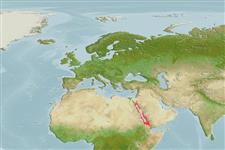Common names from other countries
>
Clupeiformes (Herrings) >
Dorosomatidae (Gizzard shads and sardinellas)
Etymology: Herklotsichthys: After Janus Adrian Herklots, Australian ichthyologist, 1820-1872.
More on author: Rüppell.
Environment: milieu / climate zone / depth range / distribution range
Ekologi
marina; djupintervall 0 - 50 m (Ref. 188). Subtropical; 37°N - 12°N, 29°E - 45°E (Ref. 188)
Western Indian Ocean: Red Sea and possibly Gulf of Aden; an immigrant into eastern Mediterranean Sea (Ref. 188). The names Herklotsichthys punctata and Herklotsichthys punctatus have been widely misused in the literature for another species, Herklotsichthys quadrimaculatus (Ref. 188).
Size / Vikt / Age
Maturity: Lm ? range ? - ? cm
Max length : 11.7 cm TL hane/ej könsbestämd; (Ref. 124816); common length : 9.5 cm TL hane/ej könsbestämd; (Ref. 5450); publicerad maxvikt: 15.00 g (Ref. 124816)
Short description
Bestämningsnycklar | Morfologi | Morfometri
Taggstrålar i ryggfenan (totalt) : 0; Mjukstrålar i ryggfenan (totalt) : 13 - 21; Taggstrålar i analfenan: 0; Mjukstrålar i analfenan: 12 - 23. Flank silvery, without spots, but a series of small dark spots on back on either side of dorsal fin base or behind it.
Forms schools in coastal waters (Ref. 188). Marketed fresh, dried and dried salted or made into fish balls.
Life cycle and mating behavior
Maturities | Reproduktion | Spawnings | Egg(s) | Fecundities | Larver
Whitehead, P.J.P., 1985. FAO Species Catalogue. Vol. 7. Clupeoid fishes of the world (suborder Clupeoidei). An annotated and illustrated catalogue of the herrings, sardines, pilchards, sprats, shads, anchovies and wolf-herrings. FAO Fish. Synop. 125(7/1):1-303. Rome: FAO. (Ref. 188)
IUCN Red List Status (Ref. 130435)
CITES (Ref. 128078)
Not Evaluated
Threat to humans
Harmless
Human uses
Fiskeri: mindre kommeriell
Verktyg
Special reports
Download XML
Internet-källor
Estimates based on models
Preferred temperature (Ref.
115969): 25.1 - 29.4, mean 28.9 (based on 54 cells).
Phylogenetic diversity index (Ref.
82804): PD
50 = 0.5002 [Uniqueness, from 0.5 = low to 2.0 = high].
Bayesian length-weight: a=0.00912 (0.00433 - 0.01920), b=3.04 (2.87 - 3.21), in cm Total Length, based on LWR estimates for this (Sub)family-body shape (Ref.
93245).
Trofisk nivå (Ref.
69278): 3.1 ±0.3 se; based on size and trophs of closest relatives
Resiliens (Ref.
120179): Hög, lägsta populationsfördubblingstid mindre än 15 månader (Preliminary K or Fecundity.).
Fishing Vulnerability (Ref.
59153): Low vulnerability (10 of 100).
